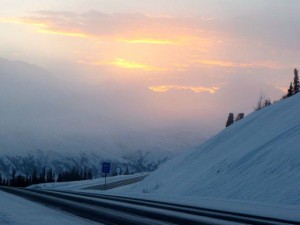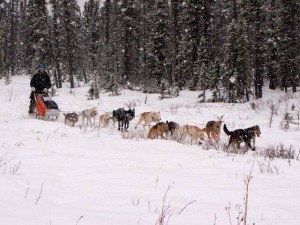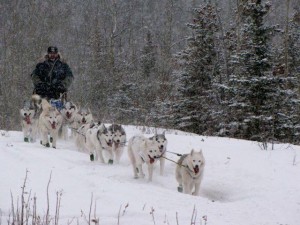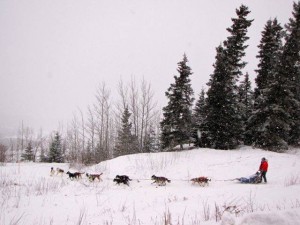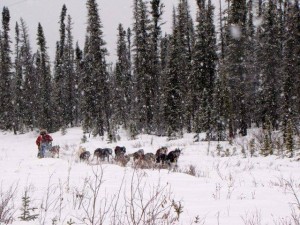Better late than never. Sorry for not being very timely with the report from the Copper Basin 300. I am not entirely sure how I managed to do it, but right after the race I came down pretty hard with a stomach bug and was out of commission for a bit. Nope, I did not steal any dog food from the gang.
It had been a few years since I last ran the ” toughest 300 Miles ” in Alaska. Although that is a very debatable point of view, the Copper Basin usually has its fair share of challenging conditions. This year the temperatures were easy on mushers and dogs, if anything a bit on the warm side along the higher ridge lines. We encountered some ice rain near Paxson on our drive down from Fairbanks and that type of weather dominated much of the CB300. Most of the way we ran dogs in a soup of ice fog mixed with some light snow. With the Copper Basin normally offering a beautiful scenery, we did not get to see any of that.
Listening to the trail report and hearing about side hill glacier where just the brushes would keep the team from sliding away into nothingness sure caught us mushers’ attention. Reports of when the trail breaker last drove through there ( about 3 or 4 days ago ) it was dry, had some mushers chuckle, others worry. In all we were pleasantly surprised by how great the trail conditions actually turned out to be, once we were out there. Job well done by the race organization and specially the trail breaker, Jeremy Kemp.
A very welcome change from previous years was that the race started right from the parking lot of the Caribou Hotel, where most mushers stayed overnight. That makes things a lot less hectic in the morning. Now add to that super well organized 6 wheeler support to the actual start line, that meant a very smooth race start for all of the teams. 49 teams crossed the line, with the first one scratching less than a mile into the race. For the other 48 teams it was a snowy run to Chisto or, better said, Red Eagle Lodge. With much of the trail following the highway there is plenty of opportunities for spectators to see the teams. A highway ditch in Alaska also means there are plenty of willow bushes, not the most pleasant trail for the dogs to run on, but from years past we all knew that this was coming our way. Many of the perceived front runners of the race had very high starting numbers. Allen Moore and Aliy Zirkle both roared by me within a few miles of the start. Once Allen tried passing Aliy right in front of me, that pass did not go very smooth. I am sure that some of the words uttered did not say ” Honey, I love you “. The Copper Basin has a mandatory 18 hrs of rest which can be taken in any of the 4 checkpoints in half hour increments. One rest has to be a minimum of 6 hrs. Strategies of where an when to take that rest vary. One consistent strategy over the past years has been by Allen Moore to take a relatively long rest early, in this case 5hrs in Red Eagle. Others wanted to keep some rest for later in the race and left after 3 hrs, where the majority of teams stayed 4 hrs.
The first half of the trail to Meiers Lake is used as a training trail by Darrin Lee and Heidi Sutter of KMA Kennel. Heidi is signed up for her rookie Iditarod debut this year. That meant the first part of the trail was well maintained and hard packed. Excelsior Creek about 4 hrs up the trail can be the first challenge in some years, with being a wet crossing. At least the crossing I found was dry. Much of the way I traveled right behind Ray Redington Jr., going over ” the hump ” crossing the Gulkana River, which was also dry, which is a very rare occurrence. Many Iditarod Teams were in the front pack. Nicolas Petit arriving first, Wade Marrs next followed by Paige Drobny, Ben Harper, who runs dogs out of the Redington Kennel and is an Iditarod Rookie for 2015. Some of the faster runtimes for this 73 mile stretch were in the 7hrs and 30 minute range.
Most teams elected to take their mandatory 6hrs layover ( plus start time differential ) in Meiers Lake, as the lodge offers good food and comfortable rooms to rest. For myself I had this originally planned too. I decided on the spur of the moment to leave after 4 hrs and do my 6 hrs in the next Checkpoint of Sourdough, not wanting to run into the heat of the day with my heavier coated dogs. Turned out that the heat of the day was no issue in the constant ice fog, but that shorting the rest was not a smart move at all, as my speed dropped drastically, losing over half an hour on this short run of 33 miles to Ray Redington, whereas our runtimes into Meiers had been comparable. It also did not help that I loaded up Henry. Yep, this armchair musher is sure out of practice, as Henry did not look 100% sound in Meiers and I am still not sure what possessed me to take him on this run.
The dogteam parking in Sourdough was a long ways away from the mushers cabin. No, really. I mean a long way. A round trip to the cabin was an easy half a mile. Still, that beats sleeping outside in ice fog. Teams left the checkpoint in short succession from about 6 p.m. on. The next run was a long one, 85 miles to the new Checkpoint of Mendeltna Lodge. After about 6 hrs teams cross Lake Louise and even in good visibility teams have gotten lost on that lake with the many different trails. Marking was excellent and teams made it across to the boat launch with no issues. The remaining section of trail to Mendeltna is best described as very bumpy and slow.
By Mendeltna the true front runners started to emerge and it was no surprise to find Allen Moore being the first team out. His strategy of early, longer rest had once again paid off. He only got to stay a short 2 hrs here, versus the 4 or even 5 hrs of many of the other teams, but the lead cushion he had built up was impressive. Now there is one way to lose that cushion quickly and that is having to turn a dogteam around. Unfortunately that is what Allen had to do, as he had trouble finding the outbound trail. Ryne Olson, who has worked for Aliy and Allen has obviously paid lots of attention to the training methods of her mentors, as she left in a strong second place, closely followed by Ray Redington Jr, who at this point was 36 minutes behind Allen.
In previous years there was one more checkpoint, Tolsona, on the way to the finish, not so this year. It was one long continuous 59 mile run to Glennallen. No chance to drop a tired dog. That led me to turn my team around after 10 minutes, to bring Crusher back into Mendeltna, another out of practice mistake. Of course by that point I sure started to ask myself what had possessed me to leave my comfy armchair to begin with. While my run to the finish can be best described as a slow slog, Ray Redington put on the afterburners and started steadily closing in on Allen, thereby passing Ryne Olson. Only 2 minutes separated Allen and Ray at the finish line. Of course, at the finish banquet, Ray could not help to mention that if the race would have been a few miles longer that he would have caught Allen, whereas Allen maintained it would have never been this close if he would not have had to double back leaving Mendeltna. Nothing better than friendly competition.
Of course not every team enters the CB300 to win. Matter of fact, with 24 rookies entered, many have an entirely different goal. To finish and more importantly to qualify for a future Iditarod. For most of those teams that means breaking the longer runs into 2 runs, camping in between Red Eagle and Meiers, or stopping somewhere past Crosswind Lake on the way to Mendeltna. Learning how to camp out is an essential skill for Iditarod also. With this dynamic, it is not surprising that it took more than 30hrs for teams to arrive at the finish line behind the winner. Matter of fact with Tom Schonberger of Eagle River the last team arriving during the finish banquet.
In all, with very few scratched teams, and only moderate ” war stories ” this 2015 Copper Basin was a great success and gives a good glimpse on who some of the strong players in Iditarod are going to be. Nicolas Petit ran a very young team, yet was able to hang with the front pack. I am sure that Ray is happy with his strong finish and Aliy Zirkle as always put in a very strong performance. Ben Harper is for sure going to try to put in a strong rookie run in Iditarod 2015 and it is nice to see an up and coming younger generation musher to do so well. With Paige Drobny and Cody Strathe both finishing in the Top 10, it is a sure sign that Squid Acres Kennel want to be more competitive in the upcoming long distance races. Watch out ” for the squids “. Matt Hall received the coveted Humanitarian Award, he sure is a name to remember for future Iditarods after placing a strong 3rd during his first Yukon Quest in 2014.
Back to the arm chair for sure for me now.
Happy trails.
All pictures courtesy of Helen Hegener.




